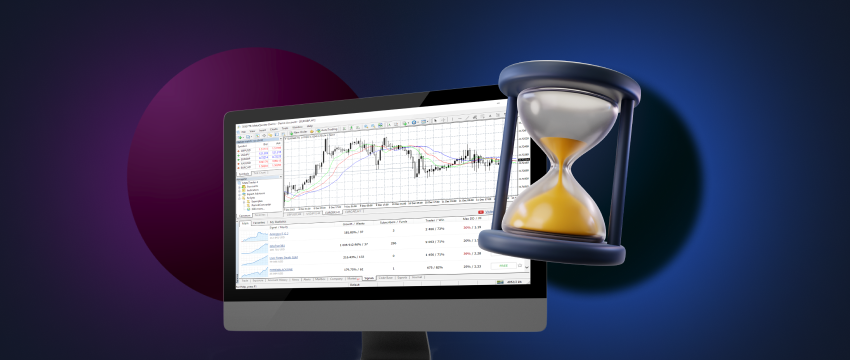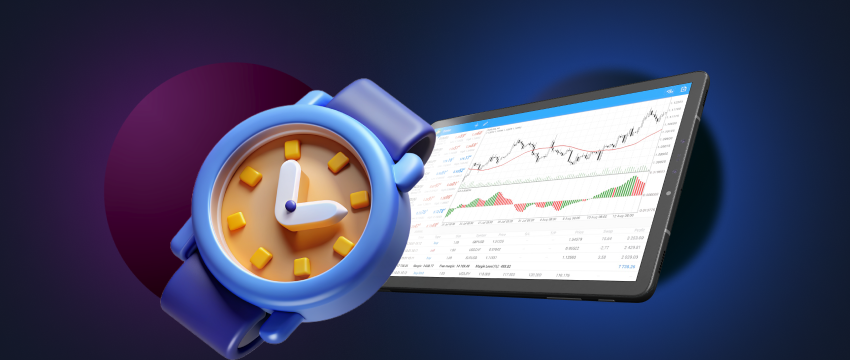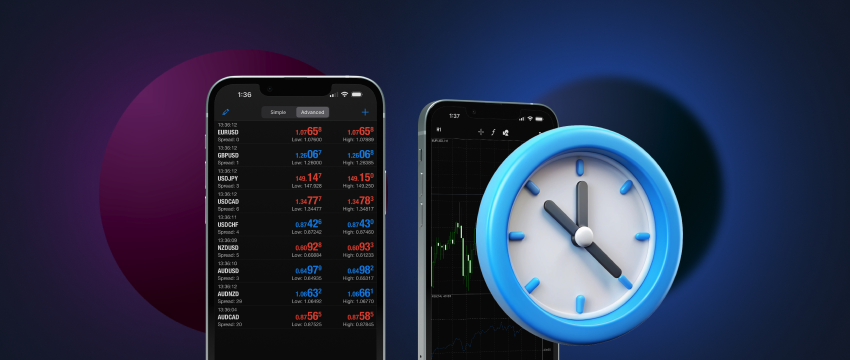O mercado de forex é conhecido pela flexibilidade que oferece aos traders, especialmente em termos do período em que as transações podem ser realizadas no mercado de forex.
O mercado de forex está essencialmente aberto 5 dias por semana. O mercado está disponível para negociação 24 horas por dia , com exceção dos fins-de-semana.
Embora seja descentralizado, o horário de negociação é orientado por quatro sessões principais, nomeadamente Tóquio, Nova Iorque, Sydney e Londres. Existe uma sobreposição entre as sessões devido aos fusos horários e os volumes de negociação variam normalmente consoante a sessão.
Uma vez que o mercado de forex funciona em vários fusos horários, pode ser acedido praticamente a qualquer hora do dia (exceto aos fins-de-semana).
Mais especificamente:
- O dia de negociação global começa com a abertura do mercado de Sydney às 7h00, hora local (16h00 EST, 21h00 UTC) e fecha às 16h00, hora local (1h00 EST, 6:00 UTC).
- Segue-se Tóquio, com abertura às 9h00, hora local (19h00 EST, 00h00 UTC) e encerra às 18h00, hora local (4h00 EST, 9h00 UTC).
- A sessão de Londres abre às 8h00, hora local (2h00 EST, 7h00 UTC) e fecha às 17h00, hora local (11h00 EST, 16h00 UTC).
- Por fim, o mercado de Nova Lorque abre às 8h00, hora local (8h00 EST, 13h00 UTC) e fecha às 17h00, hora local (17h00 EST, 22h00 UTC).
Considera-se que o período de negociação mais movimentado é durante a sobreposição das sessões de Londres e Nova Iorque (tarde de Londres, manhã de Nova Iorque).
É nesta altura que tem lugar a maior parte do volume diário de operações, que ascende a biliões de dólares. É também quando as taxas de câmbio desportivas e a prazo de referência da WM/Reuters são estabelecidas, especificamente às 16 horas, hora de Londres. Estas são amplamente utilizadas para avaliação diária e fixação de preços por gestores financeiros, fundos de pensões e outros especialistas do setor.

Como e que moedas são transacionadas?
As 10 moedas mais transacionadas no mundo estão envolvidas em aproximadamente 90% de todas as transações. Estas são o dólar americano, o euro, o iene japonês, a libra esterlina, o dólar australiano, o dólar canadiano, o franco suíço, o renminbi chinês, o dólar de Hong Kong e o dólar da Nova Zelândia.
Divisas principais, divisas secundárias e exóticas
As moedas são transacionadas em pares no mercado cambial através de produtos como os CFD (Contratos por Diferença). Os pares de moedas mais populares incluem EUR/USD, USD/JPY, GBP/USD, AUD/USD, USD/CAD, USD/CHFe NZD/USD.
Todos os pares principais incluem o USD. Os pares de moedas secundárias são aqueles que não incluem o USD e os exemplos incluem o GBP/JPY, EUR/CHF, EUR/GBP, EUR/AUD, GBP/CAD e NZD/JPY. Em comparação com os pares principais, os pares secundários utilizam normalmente spreads ligeiramente mais alargados e apresentam um pouco menos de liquidez.
Os pares de moedas exóticas incluem moedas de mercados emergentes. Os pares vêm com spreads muito mais alargados e oferecem muito menos liquidez.
Estratégias de negociação de Forex
Quando abordada com a estratégia correta, a negociação em Forex tem o potencial de oferecer retornos favoráveis. Estratégias populares como o day trading centram-se na rotação diária de posições para limitar o risco, enquanto o swing trading se estende por dias ou semanas, expondo os traders aos movimentos do mercado durante a noite.
O scalping procura obter ganhos a partir de pequenos movimentos de preços através de numerosas transações rápidas, e a negociação de posições envolve compromissos a longo prazo, por vezes com a duração de anos. A abordagem analítica varia, com a análise técnica a predominar nas estratégias a curto prazo e uma combinação de análise técnica e fundamental nas estratégias a mais longo prazo.
Mais sobre CFD
Os CFD são uma forma de derivado, o que significa que quando são negociados, não é assumida a propriedade do ativo subjacente. O contrato é celebrado entre o broker e o trader , permitindo-lhe especular sobre o movimento do preço do ativo, que no caso da negociação de forex é a taxa de câmbio. Os CFD são também instrumentos altamente alavancados.
A alavancagem oferece ao trader o potencial de uma maior exposição ao mercado do que o montante que depositou para abrir a operação, ampliando os lucros caso a transação seja bem sucedida.
No entanto, a alavancagem comporta um risco elevado, especialmente se não for gerida corretamente, e pode levar a resultados de negociação adversos e particularmente graves e a perdas substanciais.
Escolher as horas de negociação
Decidir a que horas do dia negociar depende, em última análise, de três fatores: a sua estratégia de negociação, os seus pares de moedas favoritos e a sua tolerância ao risco. Por exemplo, os day traders e scalpers podem preferir a elevada volatilidade da sobreposição Londres-Nova Iorque.
Em contrapartida, os swing traders podem concentrar-se em períodos mais calmos com menor volatilidade. Além disso, os traders também devem considerar o seu fuso horário e calendário diário, uma vez que negociar durante as horas mais ativas pode conduzir a uma melhor execução e a transações mais lucrativas.
O impacto dos comunicados de imprensa nas horas de negociação de forex
Os principais impulsionadores da volatilidade do mercado de forex incluem notícias económicas e conflitos geopolíticos. O seu impacto é normalmente sentido mais fortemente durante as sessões de Londres e Nova Iorque.
Por exemplo, os dados dos salários não agrícolas dos E.U.A., divulgados na primeira sexta-feira de cada mês, resultam frequentemente em movimentações do mercado. Os traders devem estar atentos ao calendário dos principais comunicados de imprensa e indicadores económicos, uma vez que estes podem criar movimentos de preços acentuados e uma maior volatilidade.
Uma ferramenta útil para monitorizar as notícias é um Calendário Económico. Por exemplo, o Calendário Económico da Trading Central fornece cobertura económica em tempo real, permitindo que os traders acompanhem e reajam a potenciais eventos de movimentação do mercado.
Ao tornar-se um trader da T4Trade, pode aceder ao calendário para monitorizar os eventos à medida que acontecem, mapear gráficos e índices forex para eventos, monitorizar tendências históricas e acompanhar dados macroeconómicos atualizados em tempo real para decisões de negociação mais precisas.

Ter um plano de gestão de riscos eficaz
Tendo em consideração o quão arriscada pode ser a negociação forex , é necessário um plano de gestão de risco que o ajude a mitigar grandes perdas. Este plano deve ser integrado na sua estratégia de negociação global, de modo a estar alinhado com o seu orçamento, o nível de risco em que está disposto a incorrer e os seus objetivos de negociação específicos.
Existem várias formas de os traders protegerem os seus fundos, incluindo:
- Utilizar ordens de paragem de perda para limitar as perdas. A ordem é acionada quando um preço atinge um nível pré-determinado, fechando automaticamente a posição.
- Implementing take-profit orders to lock in profits. Similar to stop-loss orders, the order is triggered when a price reaches a certain level, thereby locking in profits.
- O dimensionamento da posição, que se refere ao tamanho da posição do trader com base no nível de risco em que está preparado para incorrer.
- Diversificação dos pares de moedas, o que significa distribuir o capital por várias moedas em vez de concentrar esses fundos num só par.
- Manter um diário de trading para registar as operações e as respetivas motivações, de modo a evitar a repetição de erros no futuro
- Concentrar-se na sua psicologia de trading. Mais do que tudo, gerir as emoções durante a negociação é fundamental para tomar decisões financeiras racionais. As decisões de negociação motivadas por sentimentos como o medo, a ansiedade, o stress ou a raiva conduzem, na maioria das vezes, a maus resultados de negociação. Falta-lhes raciocínio e análise adequada, o que tem impacto no processo de tomada de decisões.

Negociar com a T4Trade
A T4Trade é um corretor popular entre os comerciantes de todo o mundo. Ela se esforça para oferecer uma excelente experiência de negociação. A T4Trade fornece acesso a uma das plataformas de negociação mais populares do mundo, a MetaTrader 4.
Oferece também amplos recursos e ferramentas educativas, incluindo um útil Calendário Económico para acompanhar os principais comunicados financeiros.
A corretor CFD oferece uma gama de tipos de contas, spreads competitivos e execuções rápidas. Além disso, a T4Trade garante depósitos e levantamentos fáceis.
Também está disponível uma equipa de apoio ao cliente multilíngue 24 horas por dia, 5 dias por semana, que está à disposição para ajudar com quaisquer dúvidas que um trader possa ter.
AVISO LEGAL: A informação disposta não deve ser interpretada como consultoria financeira ou recomendação de investimento, sendo apresentada apenas para fins de comunicação e marketing.




